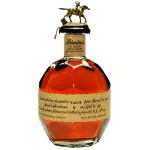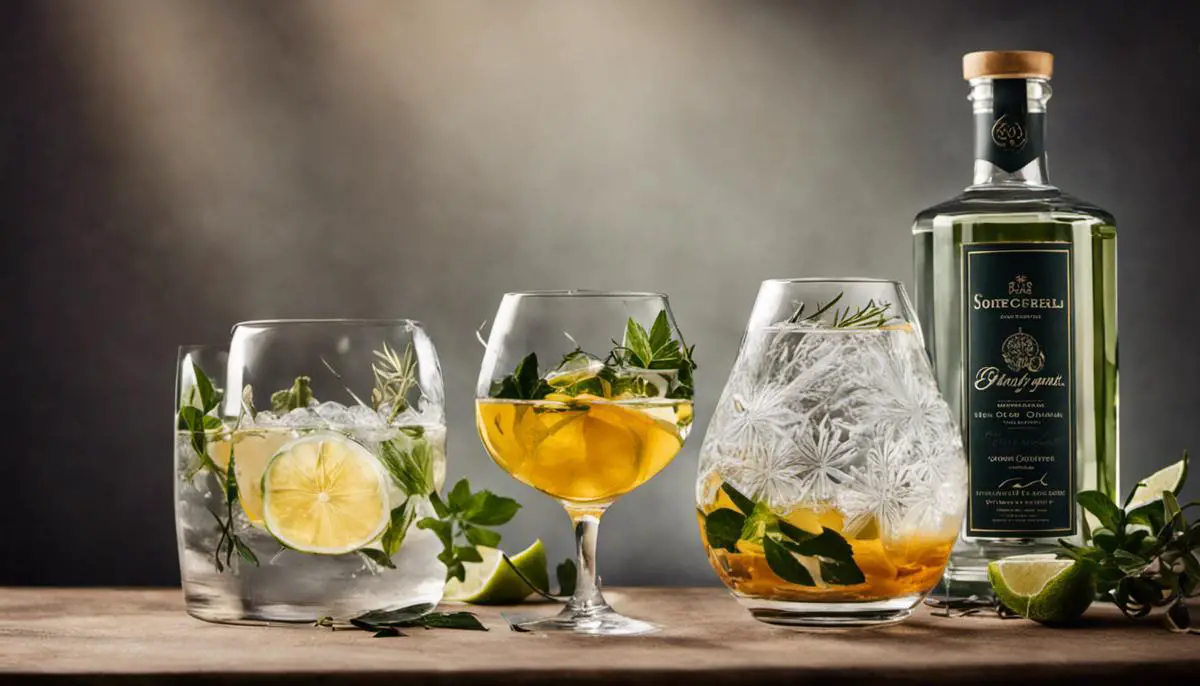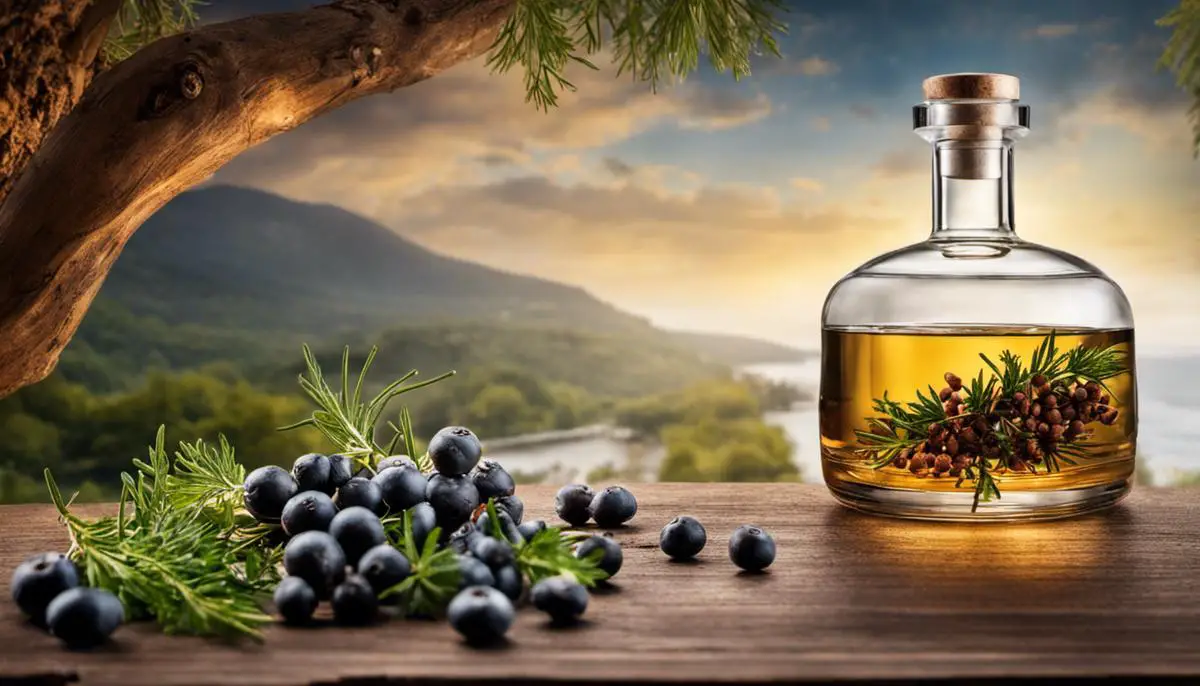The alluring world of gin showcases a diverse variety of flavors and aromas, each contributing to its unique and fascinating allure. Brought to life by the use of botanicals, the rich tapestry of gin is further enhanced by an elaborate process of distillation that infuses the spirit with a distinct taste and character. This look into the world of gin delves into the fascinating journey of gin production, from the basics of its making, the common ingredients used, to the exploration of unique botanicals. The spotlight also falls on the potential health implications of these botanicals, enriching our understanding of how they influence not only the flavor but also potentially our well-being.
The Basics of Gin Making
The Basics of Gin Making
Gin production begins with a neutral, colorless alcohol base typically derived from grains such as corn, rye, or wheat. The base spirit is distilled to a high proof and then redistilled with botanicals to infuse various aromatic flavors. The most prominent botanical used in gin production is juniper berries, hence the derivation of the word ‘gin’ from ‘jenever’, the Dutch word for juniper.
The Role of Botanicals in Gin
Botanicals are the very heart and soul of gin and it’s the choice and combination of these that truly makes each gin unique. Besides juniper, a range of other botanicals are used including coriander, angelica, citrus peel, orris root, cardamom, cassia bark, and more unconventional additions such as cucumber, rose petals, and even tea. Each botanical imparts its own unique flavor profile, whether it’s sweetness, spice, floral notes, or an exotic hint. There are no fixed laws to what can be used as botanicals, hence the vast array of gin flavors available.
Botanicals during Distillation
There are different methods in which botanicals are introduced during distillation. In the most traditional method, botanicals are steeped in the neutral spirit for several hours before distillation commences. This helps to extract the essential oils that provide the desired flavors. During distillation, the alcohol and the flavors from the botanicals turn into vapor before being condensed back into liquid. This final distillate gives the gin its distinctive flavor character.
In another approach, called the vapor infusion method, botanicals are placed in a basket or a perforated container above the still. When the alcohol boils, it evaporates through the botanicals, picking up their flavors before it condenses.
Differentiating Gin Types
The type of gin is principally determined by the production method and the kind and amount of botanicals used. London Dry Gin, for example, must predominantly taste of juniper and any flavors must be added through distillation with no artificial flavorings allowed post-distillation.
On the other hand, compound gins are made by simply flavoring neutral spirits with botanical essences or oils without redistilling. New Western or International gins, depart from the juniper-focused flavor in favor of other botanicals.
Gins like Plymouth and Old Tom represent both a brand and a style, with Plymouth having a unique geographical designation while Old Tom offers a sweeter alternative. Lastly, genever, the traditional Dutch style of gin, is maltier and reminiscent of whiskey.
Every sip of gin reflects the splendid diversity that botanicals bring, facilitating an unimaginable array of flavors suitable for differentiated palates. Whether you are relishing a refreshing gin and tonic on a sizzling summer day or savouring a sophisticated martini in a swanky bar, botanicals lay the groundwork for gin’s characteristic taste.
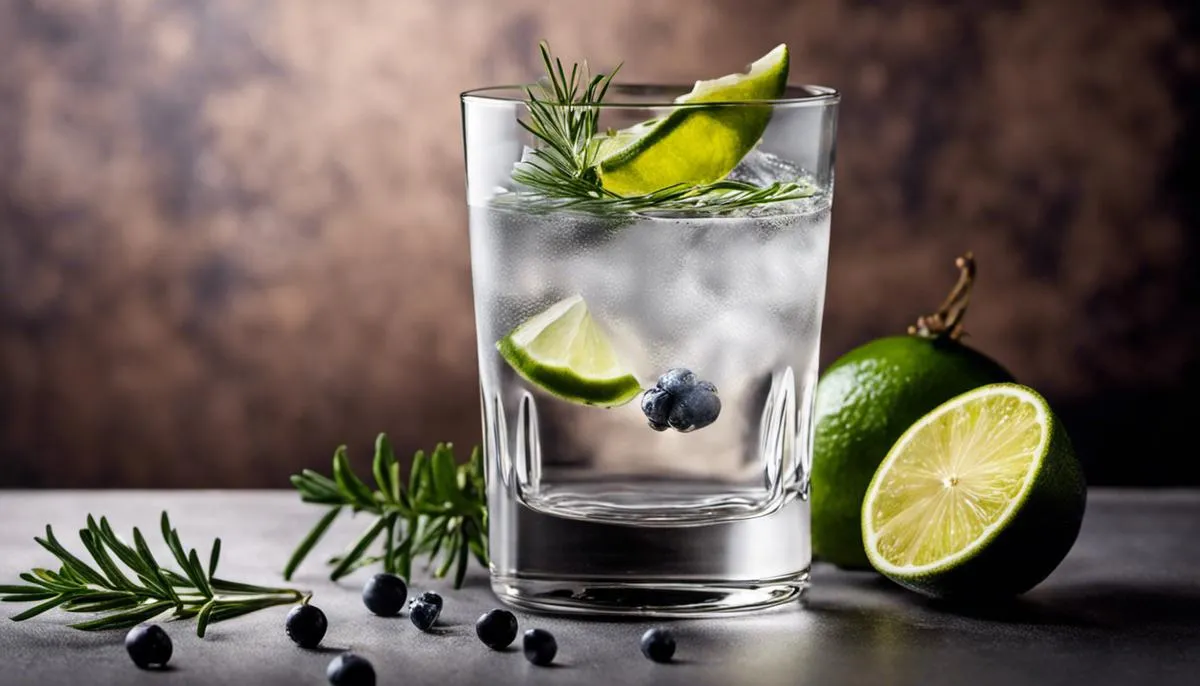
Common Botanicals in Gin
The Role of Juniper Berries in Gin
No discussion about gin can commence without the mention of its most paramount botanical- the juniper berries. The fruit of the Juniperus communis plant, juniper berries grow predominantly in parts of Europe, Asia, and North America. These berries instill gin with its distinctive flavor that toggles between sharp and sweet, replete with woody, resinous notes. A drink devoid of juniper berries’ essence cannot legally earn the ‘gin’ moniker. When it comes to influencing the gin’s taste, the flavors imparted by juniper berries lend gin its notable crisp and invigorating profile.
Coriander Seeds in Gin
Coriander seeds, another essential botanical in gin production, are harvested from the coriander plant native to Southern Europe, North Africa, and Western Asia. These seeds contribute to the complex flavor profile of gin by adding a warm, spicy, and slightly peppery note. In addition to their taste, coriander seeds are known for their aromatic qualities, contributing a citrusy scent that complements the flavors of other botanicals in gin.
Angelica Root in Gin
Originating from Northern Europe, the angelica root is a commonly used botanical that delivers a variety of flavor notes to gin. The root imparts an earthy, slightly bitter taste and is often used to balance out the sweetness of other botanicals. Despite its somewhat medicinal flavor profile, angelica root complements the taste of juniper berries and coriander seeds, creating a well-rounded flavor profile.
Citrus Peels in Gin
Citrus peels, namely from lemons and oranges, are popularly employed in gin production, lending their zesty, tangy flavors, and aromatic oils to the distillate. These peels provide a refreshing note that lightens the gin’s flavor profile and adds an element of complexity. They can be sourced globally, with different regions’ citrus fruits imparting distinct flavor characteristics. Whether it’s the intense sourness of a lemon or the sweet, slightly bitter flavor of an orange, citrus peels enhance the gin’s overall taste.
Orris Root in Gin
Derived from the iris flower, orris root is another botanical frequently used in gin production. Soaked and then distilled, orris root provides a hint of sweet floral notes, layered with a slight bitterness. Along with adding to the flavor profile, orris root acts as a binder, allowing the flavors from the other botanicals to meld together coherently. It is essential for creating balanced, complex gins.
Cassia Bark in Gin
Cassia bark, often referred to as Chinese cinnamon, brings a warm, sweet and somewhat spicy flavor to gin. Native to South China, this botanical enhances the complexity of gin, adding depth and an exotic touch to the overall profile. Alongside its flavor contribution, the cassia bark also brings a rich, golden color to some gins.
Gin is an incredibly diverse spirit that owes its wide-ranging flavor profiles to the careful use of botanicals in its production. The unique proportion and combination of botanicals used in each gin distillery is nothing short of artistic. Each distillery typically has its own guarded blend of botanicals that together determine the ensuing flavors and character of the gin, making the journey through the gin universe rich, exciting, and wonderfully diverse.
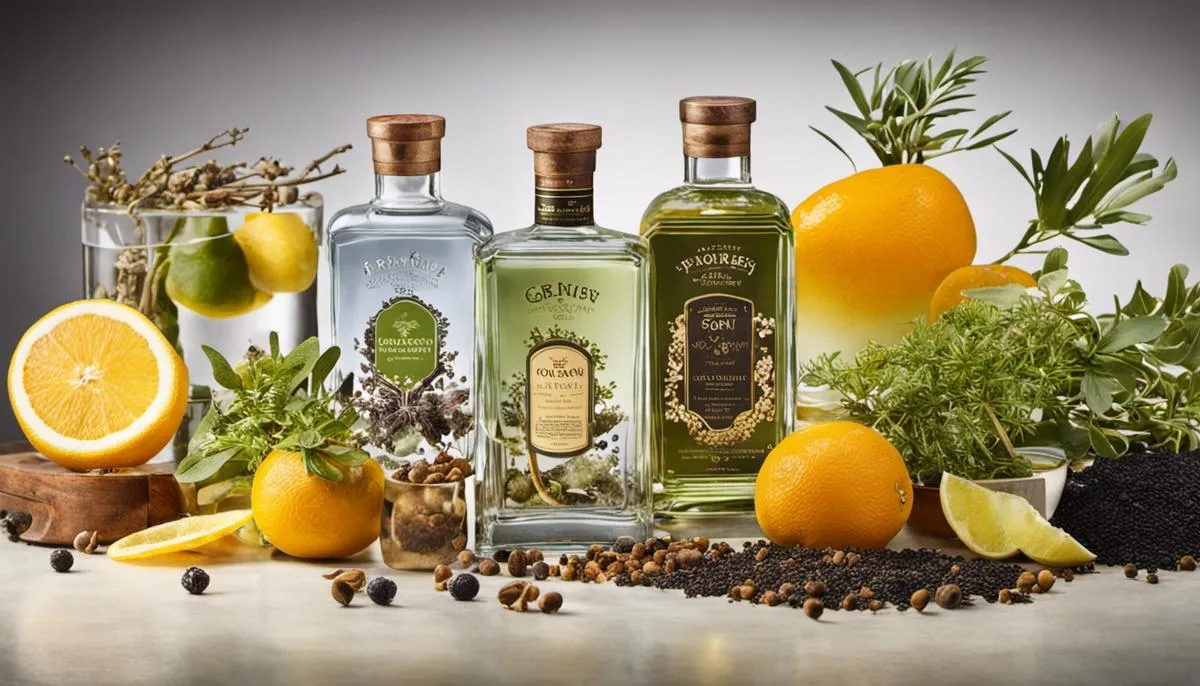
Exploring Unique Botanicals in Gin
Digging Deeper into Botanicals in Gin
Characteristically defined by the predominant use of juniper berries, gin is a spirit that has undergone a celebrated revival in craft beverage circles recently. However, a gin’s identity extends far beyond just juniper berries – a myriad of additional botanicals lend their unique flavors and qualities to each brand. These botanicals range from common to exotic, making the process of creating a standout gin both an art and a science.
Typical Botanicals Used in Gin
Botanicals used in gin production are divided into three major categories: base botanicals, body botanicals, and top note botanicals. Base botanicals provide the overall structure and ‘gin’ character to the spirit. Examples of these include juniper berries, angelica root, and coriander seeds. Body botanicals make up the mid-palate and can range from traditional agricultural herbs to wild foraged ingredients from various regions of the world. Lastly, top note botanicals, which usually are highly aromatic and volatile ingredients like citrus peel, pepper, or floral parts, give the final touch and define the gin’s finishing notes.
Unique and Less Common Botanicals
Artisanal gin producers constantly experiment with unique, less common botanicals to create nuanced and stand-out gins. Botanicals like Australian finger lime, bush tomato, sea lettuce, or even ants have made their way into innovative gins. These unique ingredients not only offer unusual flavor profiles, but some, like ants, add a surprise element to catch consumers’ interest.
Botanicals from Different Geographic Regions
The geographical region where botanicals grow can significantly influence their flavor profiles. Finger limes from Australia add a zesty, tropical citrus note, while meditation herbs from the Alps give a calming, earthy undertone. Japanese yuzu imparts a tart, grapefruit-like flavor with overtones of mandarin orange, fitting in perfectly with the citrus family typically used in gin.
Creative use of Botanicals
Creative use of botanicals can help a brand stand out in a crowded marketplace. Some producers are turning to local, foraged botanicals to showcase their regional identity. For example, rye based gin uses locally sourced apple, cranberry, and wild herbs to provide a flavor profile that is unique to the terroir. Using unusual botanicals, producers can also craft gins for specific purposes like a gin specifically designed for a classic Martini, using botanicals that complement the other ingredients.
Botanicals: The Cornerstone of Gin’s Future
With the future of gin resting on the talents of innovative distillers pushing the boundaries of flavour with botanicals, the gin industry is under a thrilling revolution. As consumers’ palates become more adventurous, there’s an increasing demand for unique taste experiences. This drives the industry to experiment with unconventional botanicals and new-age distilling techniques. Truly, we are in the golden age of gin, with a myriad of flavour adventures waiting to be embarked upon.
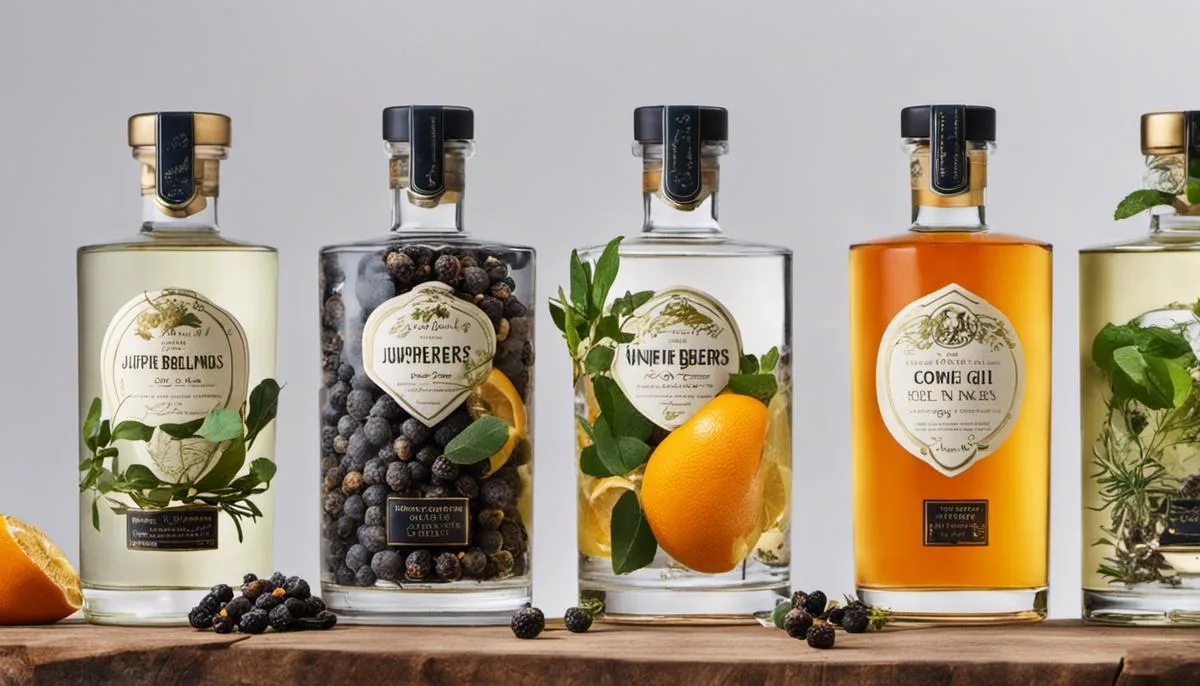
Impact on Health
A Healthier Perspective: Botanicals in Gin
Known for its distinct flavor, the popularity of gin as an alcoholic beverage is mostly attributed to the diverse botanicals employed in its production. Juniper berries, an ever-present ingredient, provides the unique taste characteristic of gin. Their potential healing properties, such as treating digestive issues, cardiac conditions, and infections, are even recognized by the World Health Organization. Yet, the health benefits stemming from gin production aren’t limited to juniper berries; a plethora of other botanicals could also offer medicinal properties.
Let’s take coriander, another staple in gin production, which is celebrated for its digestive benefits, anti-flatulent, and anti-inflammatory properties, and potential antibacterial activity. The resinous flavor often found in gin, credited to grains of paradise, might have medicinal advantages too. It’s been suggested these seeds aid digestion, lessen inflammation, and provide pain relief. Furthermore, Orrisroot, used in gin as a fixative, has been identified as having diuretic and expectorant properties.
Potential Risks of Botanicals in Gin
However, while there are potential health benefits, it is also crucial to discuss potential risks associated with botanicals in gin. Among them, the risk of allergic reactions stands prominent. For example, those allergic to certain spices might react adversely to a gin that uses those botanicals.
Wormwood, while it lends a distinctive bitter flavor to some styles of gin, has been associated with hallucinogenic properties and potential liver damage when used in excessive amounts. The European Union has set limits on the amount of thujone, the toxic compound found in wormwood, that can be present in food and beverages, including gin.
Also worth noting is that while botanicals may have medicinal properties, consuming them in a distilled and alcoholic form like gin changes the dynamics. Alcohol, even when flavored with health-boosting botanicals, is not an ideal medium for administering therapeutic doses of these compounds. In fact, the downsides of alcohol consumption, such as addiction, liver damage, and other health issues, often outweigh the potential benefits offered by the botanicals.
Impact of Botanicals on Overall Health
In theory, botanicals in gin could provide a host of health benefits, such as aiding digestion, reducing inflammation, and fighting bacterial infections. However, scientific research on the health impact of gin botanicals is limited. Further studies are required to conclusively determine the medicinal value these botanicals retain after the distillation process and whether these benefits can effectively counterbalance the negative effects of alcohol.
Moreover, the potential for allergic reactions and toxicity from certain botanicals must be considered. Ensuring you’re aware of the botanicals present in the gin you consume can provide insights into potential health benefits or risks.
In summary, while gin botanicals may have potential health benefits, the alcohol in gin can pose significant health risks. As with any alcoholic beverage, moderation is key.

As we’ve explored, gin owes much of its charismatic flavor and unique character to the intriguing array of botanicals involved during its production. Whether it’s a commonly used botanical like juniper berries or a unique addition from an obscure corner of the world, each element lends itself to the overall symphony of tastes. However, the presence of these botanicals also makes a foray into the potential health impacts, some presenting potential benefits while others may pose allergenic risks. It’s essential to appreciate how the world of gin, much like the world of nature that inspires it, is a mixture of bitter and sweet, benefit and risk, surprise and familiarity.

